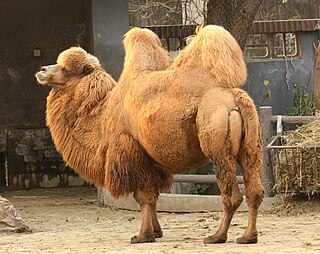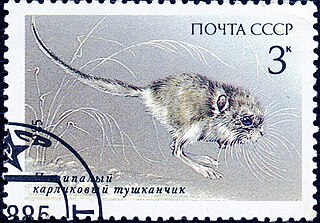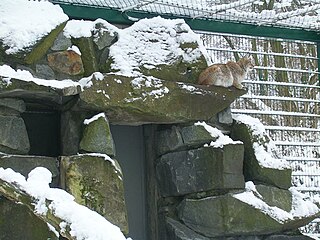 W
WThe Alashan ground squirrel is a species of squirrel. It is native to China and Mongolia.
 W
WThe saiga antelope, or saiga, is a critically endangered antelope which during antiquity inhabited a vast area of the Eurasian steppe spanning the foothills of the Carpathian Mountains in the northwest and Caucasus in the southwest into Mongolia in the northeast and Dzungaria in the southeast. During the Pleistocene, they also occurred in Beringian North America and the British Isles. Today, the dominant subspecies is only found in one region in Russia and three areas in Kazakhstan. A portion of the Ustiurt population migrates south to Uzbekistan and occasionally Turkmenistan in winter. It is extinct in China and southwestern Mongolia. It was hunted extensively in Romania and Moldova until it became extinct in those regions at the end of the 18th century. The Mongolian subspecies is found only in western Mongolia.
 W
WThe Asian badger, also known as the sand badger is a species of badger native to Mongolia, China, Kazakhstan, Kyrgyzstan, the Korean Peninsula and Russia.
 W
WThe Bactrian camel, also known as the Mongolian camel, is a large even-toed ungulate native to the steppes of Central Asia. It has two humps on its back, in contrast to the single-humped dromedary camel. Its population of two million exists mainly in the domesticated form. Their name comes from the ancient historical region of Bactria.
 W
WThe greater tube-nosed bat is a species of bat. An adult greater tube-nosed bat has a body length of 4.2-5.7 cm, a tail length of 3.6-4.1 cm, and a wing length of 3.7-4.4 cm. The species is found in India, Mongolia, China, and Korea.
 W
WPallas's cat, also called the manul, is a small wild cat with a broad, but fragmented distribution in the grasslands and montane steppes of Central Asia. It is negatively affected by habitat degradation, prey base decline and hunting. It has been classified as Least Concern on the IUCN Red List since 2020.
 W
WThe Chinese striped hamster, also known as the striped dwarf hamster, is a species of hamster. It is distributed across Northern Asia, from southern Siberia through Mongolia and northeastern China to northern North Korea. An adult Chinese striped hamster weighs 20 to 35 g, and has a body length of 72 to 116 mm with a tail of 15 to 26 mm. It is smaller and has a much shorter tail than the greater long-tailed hamster, Tscherskia triton, which inhabits much of the same range.
 W
WThe desert hare is a species of hare found in Northwest China and countries adjacent to it. Little is known about this species except that it inhabits grassland and scrub areas of desert and semi-desert. The International Union for Conservation of Nature has assessed its conservation status as being of "least concern."
 W
WThe elk or wapiti is one of the largest species within the deer family, Cervidae, and one of the largest terrestrial mammals in North America and Northeast Asia. It is not to be confused with the still larger moose of North America, alternatively known as "elk" in British English and related names in other European languages, in reference to populations in Eurasia. Elk range in forest and forest-edge habitat, feeding on grasses, plants, leaves, and bark. Male elk have large antlers which are shed each year. Males also engage in ritualized mating behaviors during the rut, including posturing, antler wrestling (sparring), and bugling, a loud series of vocalizations that establishes dominance over other males and attracts females.
 W
WThe Eurasian beaver or European beaver is a beaver species that was once widespread in Eurasia, but was hunted to near-extinction for both its fur and castoreum. At the turn of the 20th century, only about 1,200 beavers survived in eight relict populations in Europe and Asia. It has been reintroduced to much of its former range, and now occurs from Spain, Central Europe, Great Britain and Scandinavia to a few regions in China and Mongolia. It is listed as least concern on the IUCN Red List, as it recovered well in most of Europe. It is extinct in Portugal, Moldova, and Turkey.
 W
WThe harvest mouse is a small rodent native to Europe and Asia. It is typically found in fields of cereal crops, such as wheat and oats, in reed beds and in other tall ground vegetation, such as long grass and hedgerows. It has reddish-brown fur with white underparts and a naked, highly prehensile tail, which it uses for climbing. It is the smallest European rodent; an adult may weigh as little as 4 grams (0.14 oz). It eats chiefly seeds and insects, but also nectar and fruit. Breeding nests are spherical constructions carefully woven from grass and attached to stems well above the ground.
 W
WThe five-toed pygmy jerboa is a species of rodent in the family Dipodidae. It is monotypic within the genus Cardiocranius. It is found in China, Kazakhstan, and Mongolia.
 W
WThe corsac fox, also known simply as a corsac, is a medium-sized fox found in steppes, semi-deserts and deserts in Central Asia, ranging into Mongolia and northeastern China. Since 2004, it has been classified as least concern by IUCN, but populations fluctuate significantly, and numbers can drop tenfold within a single year. It is also known as the steppe fox. The word "corsac" is derived from the Russian name for the animal, "korsák" (корса́к), derived ultimately from Turkic "karsak".
 W
WThe goitered or black-tailed gazelle is a gazelle found in Georgia, Azerbaijan, Iran, parts of Iraq and Pakistan, Afghanistan, Tajikistan, Kyrgyzstan, Uzbekistan, Turkmenistan, Kazakhstan and in northwest China and Mongolia. The specific name, meaning "full below the throat", refers to the male having an enlargement of the neck and throat during the mating season.
 W
WThe Mongolian gazelle, or dzeren, is a medium-sized antelope native to the semiarid Central Asian steppes of Mongolia, as well as some parts of Siberia and China. The name dzeren is Russian misinterpretation of the Mongolian language name of zeer.
 W
WA gerbil is a small mammal of the subfamily Gerbillinae in the order Rodentia. Once known as desert rats, the gerbil subfamily includes about 110 species of African, Indian, and Asian rodents, including sand rats and jirds, all of which are adapted to arid habitats. Most are primarily active during the day, making them diurnal, and almost all are omnivorous. Gerbils are related to mice and rats; they all belong to the family Muridae.
 W
WThe Gobi bear (Ursus arctos gobiensis; known in Mongolian as the Mazaalai, is a subspecies of the brown bear that is found in the Gobi Desert of Mongolia. It is listed as critically endangered by the Mongolian Redbook of Endangered Species and by the Zoological Society of London. The population included only around 30 adults in 2009, and is separated by enough distance from other brown bear populations to achieve reproductive isolation.
 W
WThe great gerbil is a large gerbil found throughout much of Central Asia.
 W
WHoffmann's pika is a species of mammal in the pika family, Ochotonidae, that is endemic to Mongolia. It is currently listed as endangered by the International Union for Conservation of Nature (IUCN).
 W
WThe hog badger, also known as the greater hog badger, is a terrestrial mustelid native to Central and Southeast Asia. It is listed as Vulnerable in the IUCN Red List of Threatened Species because the global population is thought to be declining due to high levels of poaching.
 W
WThe snow leopard, also known as the ounce, is a large cat native to the mountain ranges of Central and South Asia. It is listed as Vulnerable on the IUCN Red List because the global population is estimated to number less than 10,000 mature individuals and is expected to decline about 10% by 2040. It is threatened by poaching and habitat destruction following infrastructural developments. It inhabits alpine and subalpine zones at elevations from 3,000 to 4,500 m, ranging from eastern Afghanistan, the Himalayas and the Tibetan Plateau, to southern Siberia, Mongolia, and western China. In the countries in the northern part of its range, it also lives at lower elevations.
 W
WThe long-eared jerboa is a nocturnal mouse-like rodent with a long tail, long hind legs for jumping, and exceptionally large ears. It is distinct enough that authorities consider it to be the only member of both its genus, Euchoreutes, and subfamily, Euchoreutinae.
 W
WThe Eurasian lynx is a medium-sized wild cat native to Northern, Central and Eastern Europe to Central Asia and Siberia, the Tibetan Plateau and the Himalayas. It inhabits temperate and boreal forests up to an elevation of 5,500 m (18,000 ft). Despite its wide distribution, it is threatened by habitat loss and fragmentation, poaching and depletion of prey.
 W
WThe Turkestan lynx is a subspecies of Eurasian lynx native to Central Asia. It is also known as Central Asian lynx, Tibetan lynx or Himalayan lynx. It is widespread from west in Central Asia, from South Asia to China and Mongolia. There are 27,000 mature individuals in China as of 2013. It is proposed for the Turkestan lynx to be listed as Vulnerable in Uzbekistan.
 W
WThe Manchurian wapiti is a subspecies of Cervus canadensis, native to eastern Asia.
 W
WThe Mongolian wild ass, also known as Mongolian khulan, is the nominate subspecies of the onager. It is found in southern Mongolia and northern China. It was previously found in eastern Kazakhstan and southern Siberia before being extirpated there through hunting. As of 2015, the Mongolian wild ass is listed as Near Threatened by the IUCN. Current population estimates are approximately 42,000 individuals in Mongolia and around 5,000 individuals in Northern China.
 W
WThe moose or elk (Eurasia), Alces alces, is a member of the New World deer subfamily and is the largest and heaviest extant species in the deer family. Most adult male moose have distinctive broad, palmate antlers; most other members of the deer family have antlers with a dendritic ("twig-like") configuration. Moose typically inhabit boreal forests and temperate broadleaf and mixed forests of the Northern Hemisphere in temperate to subarctic climates. Hunting and other human activities have caused a reduction in the size of the moose's range over time. It has been reintroduced to some of its former habitats. Currently, most moose occur in Canada, Alaska, New England, Fennoscandia, the Baltic states, and Russia. Its diet consists of both terrestrial and aquatic vegetation. The most common moose predators are the gray wolf along with bears and humans. Unlike most other deer species, moose do not form herds and are solitary animals, aside from calves who remain with their mother until the cow begins estrus, at which point the cow chases away young bulls. Although generally slow-moving and sedentary, moose can become aggressive and move quickly if angered or startled. Their mating season in the autumn features energetic fights between males competing for a female.
 W
WThe mountain hare, also known as blue hare, tundra hare, variable hare, white hare, snow hare, alpine hare, and Irish hare, is a Palearctic hare that is largely adapted to polar and mountainous habitats.
 W
WThe northern pika is a species of pika found across mountainous regions of northern Asia, from the Ural Mountains to northern Japan and south through Mongolia, Manchuria and northern Korea. An adult northern pika has a body length of 12.5–18.5 centimeters (4.9–7.3 in), and a tail of 0.5–1.2 centimeters (0.20–0.47 in). The pika sheds its fur twice annually, bearing a reddish-brown coat in the summer and grayish-brown coat in winter. It feeds on various plant material and makes "hay piles" for winter use.
 W
WThe onager, also known as hemione or Asiatic wild ass, is a species of the family Equidae native to Asia. A member of the subgenus Asinus, the onager was described and given its binomial name by German zoologist Peter Simon Pallas in 1775. Five subspecies have been recognized, one of which is extinct.
 W
WPrzewalski's horse, Equus przewalskii or Equus ferus przewalskii, also called the takhi, Mongolian wild horse or Dzungarian horse, is a rare and endangered horse native to the steppes of central Asia. At one time extinct in the wild, it has been reintroduced to its native habitat since the 1990s in Mongolia at the Khustain Nuruu National Park, Takhin Tal Nature Reserve, and Khomiin Tal. The taxonomic position is still debated, with some taxonomists treating Przewalski's horse as a species, E. przewalskii, others as a subspecies of wild horse or a feral variety of the domesticated horse (E. f. caballus). It is named after the Russian geographer and explorer Nikołaj Przewalski.
 W
WThe red squirrel or Eurasian red squirrel is a species of tree squirrel in the genus Sciurus common throughout Eurasia. The red squirrel is an arboreal, primarily herbivorous rodent.
 W
WThe sable is a species of marten, a small omnivorous mammal primarily inhabiting the forest environments of Russia, from the Ural Mountains throughout Siberia, and northern Mongolia. Its habitat also borders eastern Kazakhstan, China, North Korea and Hokkaidō, Japan. Its range in the wild originally extended through European Russia to Poland and Scandinavia. Historically, it has been hunted for its highly valued dark brown or black fur, which remains a luxury good to this day. While hunting is still common in Russia, most fur on the market is now commercially farmed.
 W
WThe Siberian large-toothed shrew is a species of shrew. An adult Siberian large-toothed shrew has a weight of 4.6-6.0 grams and a body length of 5.5-6.4 centimeters, with a tail of 2.4-3.75 centimeters. This species is found across Northeast Asia, from Mongolia through northeastern China to the Russian Far East and the Paektusan region of North Korea.
 W
WThe tamarisk jird is a species of rodent in the family Muridae. It is found in China, Mongolia, Kazakhstan, Kyrgyzstan, Russia, Turkmenistan, and Uzbekistan. It prefers habitats with grass or shrub cover.
 W
WThe Tarbagan marmot is a species of rodent in the family Sciuridae. It is found in China, northern and western Mongolia, and Russia. In the Mongolian Altai the range overlaps with that of the Gray marmot. The species was classified as endangered by the IUCN in 2008.
 W
WThe Tian Shan dhole, also known as the Siberian dhole, western Asiatic dhole, or northern dhole is a subspecies of dhole native to the Altai and Tian Shan mountain ranges, and possibly Pamir and Kashmir.
 W
WThe Ussuri dhole, also known as the Indian dhole, Eastern Asiatic dhole, Chinese dhole or Southern dhole, is the nominate subspecies of the dhole native to East Asia. It is widespread in the Indian subcontinent and the Indochinese Peninsula. The Ussuri dhole is also native to China, however it is probably extinct in most of its ranges in China, as well as in Mongolia and the Russian Far East.
 W
WThe wild Bactrian camel is a critically endangered species of camel living in parts of northern China and southern Mongolia. It is closely related to the Bactrian camel. Both are large, double-humped even-toed ungulates native to the steppes of central Asia. Until recently, wild Bactrian camels were thought to have descended from domesticated Bactrian camels that became feral after being released into the wild. However, genetic studies have established it as a separate species which diverged from the Bactrian camel about 1.1 million years ago.
 W
WThe Mongolian wolf is a subspecies of the grey wolf which is native to Mongolia, northern and central China, Korea, and the Ussuri region of Russia.
 W
WThe domestic yak is a long-haired domesticated cattle found throughout the Himalayan region of the Indian subcontinent, the Tibetan Plateau, Northern Myanmar, Yunnan, Sichuan and as far north as Mongolia and Siberia. It is descended from the wild yak.